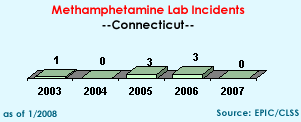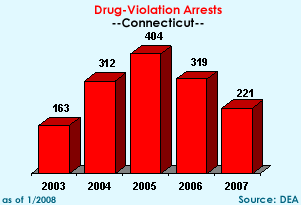|
DEA
Offices & Telephone Nos.
Bridgeport—203-579-5591
Hartford—860-240-3233
New Haven—203-497-5200 |
State Facts
Population: 3,510,297
State Prison Population: 19,497
Probation Population: 52,092
Violent Crime Rate
National Ranking: 34 |
2007
Federal Drug Seizures
Cocaine: 52.0 kgs.
Heroin: 4.6 kgs.
Methamphetamine: 1.3 kgs.
Marijuana: 258.3 kgs.
Hashish: 0.0 kgs.
MDMA: 0.0 kgs./88 du
Meth Lab Incidents: 0 (DEA, state, and local) |
Drug
Situation: Heroin and cocaine in powder and crack form are the greatest drug threats in Connecticut. Located in close proximity to NYC, Connecticut is an important transit and destination area for drugs. Interstate 95, the major north-south route on the East Coast, extends along Connecticut’s southern shore through Stamford, Bridgeport, New Haven and New London. It connects New York City with Boston and continues to the U.S. -Canada border. Interstate 91 extends from New Haven north to Massachusetts, Vermont and the U.S. -Canada border. These interstates intersect in New Haven and from what is known by law enforcement as the New England Pipeline. (And Interstate 84).
 Cocaine:
Cocaine is still a popular drug of choice and still widely abused in Connecticut, with crack historically preferred over powder, although powder cocaine has recently experienced a surge in popularity among wholesale dealers due to the lower wholesale price of powder cocaine from New York-based suppliers. When needed, cocaine is converted to crack cocaine locally, although wholesale dealers increasingly prefer to sell powder in the interest of greater profit. Street level distribution of cocaine seems to still be controlled primarily by Puerto Rican and African American groups. Cocaine is available in many sizes from gram to kilogram quantities. The majority of cocaine smuggling and distribution organizations are now comprised of a mix of Puerto Rican, Mexican, and African American individuals often working in concert. Cocaine has traditionally, and continues to arrive in Connecticut from New York via automobiles sometimes equipped with sophisticated hidden compartments. Sources of supply for cocaine also included Mexican transportation groups based in mid-Atlantic, southern, and western states throughout the U.S. Local prices of cocaine fluctuate greatly in reaction to availability in source areas. Cocaine:
Cocaine is still a popular drug of choice and still widely abused in Connecticut, with crack historically preferred over powder, although powder cocaine has recently experienced a surge in popularity among wholesale dealers due to the lower wholesale price of powder cocaine from New York-based suppliers. When needed, cocaine is converted to crack cocaine locally, although wholesale dealers increasingly prefer to sell powder in the interest of greater profit. Street level distribution of cocaine seems to still be controlled primarily by Puerto Rican and African American groups. Cocaine is available in many sizes from gram to kilogram quantities. The majority of cocaine smuggling and distribution organizations are now comprised of a mix of Puerto Rican, Mexican, and African American individuals often working in concert. Cocaine has traditionally, and continues to arrive in Connecticut from New York via automobiles sometimes equipped with sophisticated hidden compartments. Sources of supply for cocaine also included Mexican transportation groups based in mid-Atlantic, southern, and western states throughout the U.S. Local prices of cocaine fluctuate greatly in reaction to availability in source areas.
 Heroin:
Demand for heroin remains high and is easily accessible. Popularity of heroin is due, in part, to increased availability of low cost, high purity heroin that can be effectively snorted or smoked rather than injected. Abuse remains widespread, affecting both suburban and urban areas. Connecticut based Dominican and other Hispanic criminal groups are the dominate transporters and wholesale and midlevel distributors of heroin in the state. As in the past, heroin is still sold on the street in small glassine bags, although fewer have any type of marking or “brand name” on the package. The heroin is primarily being transported into Connecticut from New York City, usually entering the region via one the major interstates in automobiles equipped with hidden hydraulic compartments or “traps.” Large quantities of heroin arrive in the state via shipping services, such as UPS and via airplanes by way of human couriers. Heroin:
Demand for heroin remains high and is easily accessible. Popularity of heroin is due, in part, to increased availability of low cost, high purity heroin that can be effectively snorted or smoked rather than injected. Abuse remains widespread, affecting both suburban and urban areas. Connecticut based Dominican and other Hispanic criminal groups are the dominate transporters and wholesale and midlevel distributors of heroin in the state. As in the past, heroin is still sold on the street in small glassine bags, although fewer have any type of marking or “brand name” on the package. The heroin is primarily being transported into Connecticut from New York City, usually entering the region via one the major interstates in automobiles equipped with hidden hydraulic compartments or “traps.” Large quantities of heroin arrive in the state via shipping services, such as UPS and via airplanes by way of human couriers.
  Methamphetamine:
Lab seizures have not increased in Connecticut. All methamphetamine labs seized in the Northeast have been low-capacity labs, usually producing two ounces or less of the drug per production cycle. These labs are usually located inside private residence. No information is available on street level sales of Methamphetamine. Methamphetamine:
Lab seizures have not increased in Connecticut. All methamphetamine labs seized in the Northeast have been low-capacity labs, usually producing two ounces or less of the drug per production cycle. These labs are usually located inside private residence. No information is available on street level sales of Methamphetamine.
 Club
Drugs: Popularity of MDMA/Ecstasy has slipped, even among college age individuals residing in Connecticut. MDMA is transported from Florida and Mexico via mail services. MDMA is also purchased in New York or Canada and transported to Connecticut. Club
Drugs: Popularity of MDMA/Ecstasy has slipped, even among college age individuals residing in Connecticut. MDMA is transported from Florida and Mexico via mail services. MDMA is also purchased in New York or Canada and transported to Connecticut.
 Marijuana: Marijuana can still be obtained throughout Connecticut. The majority of high grade marijuana available in Connecticut comes from either Canada, out of state indoor grow operations, Mexico, and or the Southwest areas of the U.S. Marijuana is readily available in the state of Connecticut for individual use and available in multi-ounce/pound quantities for wholesale distribution. Caucasian criminal groups smuggle high quality, Canadian produced marijuana across the U.S. –Canada border primarily via private vehicle. An increase in sophisticated indoor hydroponic marijuana growth sites have been revealed around the state in recent years. These operations are able to bypass detection by the utility companies, therefore evading notification to law enforcement, by expertly wiring electric connections through an alternate location, and increasingly through the use of generators at grow sites. Marijuana: Marijuana can still be obtained throughout Connecticut. The majority of high grade marijuana available in Connecticut comes from either Canada, out of state indoor grow operations, Mexico, and or the Southwest areas of the U.S. Marijuana is readily available in the state of Connecticut for individual use and available in multi-ounce/pound quantities for wholesale distribution. Caucasian criminal groups smuggle high quality, Canadian produced marijuana across the U.S. –Canada border primarily via private vehicle. An increase in sophisticated indoor hydroponic marijuana growth sites have been revealed around the state in recent years. These operations are able to bypass detection by the utility companies, therefore evading notification to law enforcement, by expertly wiring electric connections through an alternate location, and increasingly through the use of generators at grow sites.
Pharmaceutical Diversion: Diverted pharmaceuticals such as OxyContin, Vicodin, Oxycodone, Hydocodone, Methadone, Ritalin, Xanax and Diazepam, are highly abused in Connecticut. The diversion and abuse of prescription opiates such as OxyContin, Vicodin, and Percocet are increasing rapidly. Diverted pharmaceuticals typically are obtained through common diversion techniques including prescription fraud, improper prescribing practices, “doctor shopping” (visiting multiple doctors to obtain prescriptions), and pharmacy theft. Local independent dealers and abusers are the primary retail-level distributors of diverted pharmaceuticals in Connecticut.
 Other
Drugs: PCP is typically transported into Connecticut from the southwestern United States and the New York City area through the use of couriers, although local PCP labs have recently been identified in Connecticut. PCP is sprayed on crushed mint leaves or marijuana and then smoked. Loose PCP-laced marijuana, often packaged in a plastic bag, is called “wet” and PCP-laced blunts are called “illy”. Other
Drugs: PCP is typically transported into Connecticut from the southwestern United States and the New York City area through the use of couriers, although local PCP labs have recently been identified in Connecticut. PCP is sprayed on crushed mint leaves or marijuana and then smoked. Loose PCP-laced marijuana, often packaged in a plastic bag, is called “wet” and PCP-laced blunts are called “illy”.
DEA Mobile Enforcement Teams: This cooperative program with state and local law enforcement counterparts was conceived in 1995 in response to the overwhelming problem of drug-related violent crime in towns and cities across the nation. Since the inception of the MET Program, 473 deployments have been completed nationwide, resulting in 19,643 arrests. There have been two MET deployments in the State of Connecticut since the inception of the program, Bridgeport and Hartford.
DEA
Regional Enforcement Teams:
This program was designed to augment existing DEA division resources
by targeting drug organizations operating in the United States where
there is a lack of sufficient local drug law enforcement. This Program
was conceived in 1999 in response to the threat posed by drug trafficking
organizations that have established networks of cells to conduct drug
trafficking operations in smaller, non-traditional trafficking locations
in the United States. As of January 31, 2005, there have been 27 deployments nationwide, and one deployment in the U.S. Virgin Islands, resulting in 671 arrests. There have been no RET deployments in the State of Connecticut.
Drug
Courts/Treatment Centers: Currently there are 9 state treatment facilities in Connecticut.
More information
about the Boston Division Office.
Sources
Factsheet
last updated:
3/2008
Click
here for last year's 2007 factsheet >> |

